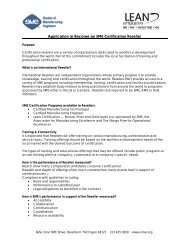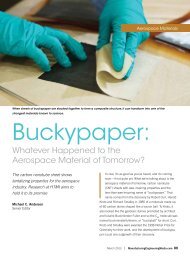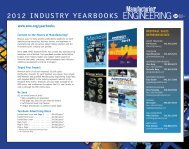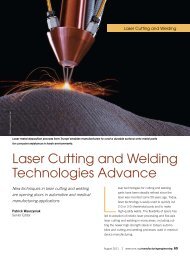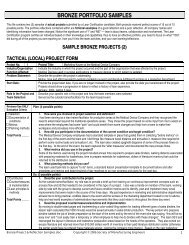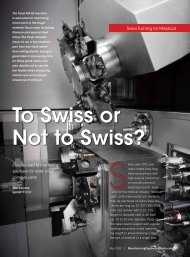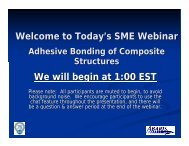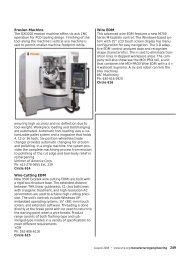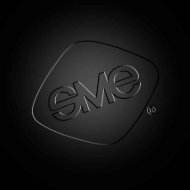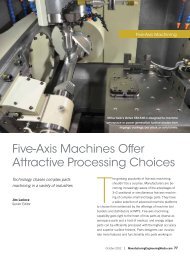The RAPID 2013 Conference & Exposition Directory - Society of ...
The RAPID 2013 Conference & Exposition Directory - Society of ...
The RAPID 2013 Conference & Exposition Directory - Society of ...
Create successful ePaper yourself
Turn your PDF publications into a flip-book with our unique Google optimized e-Paper software.
Additive Manufacturing<br />
Photo courtesy New Balance<br />
A Vibrant Future<br />
Despite the hype and half truths, additive manufacturing is<br />
gaining steam around the world. In fact, a number <strong>of</strong> national<br />
governments have committed sizable resources to the development<br />
and advancement <strong>of</strong> the technology.<br />
In August 2012, the National Additive Manufacturing Innovation<br />
Institute (NAMII) was created as the pilot institute for the<br />
National Network for Manufacturing Innovation (NNMI). <strong>The</strong><br />
NNMI is a proposed investment <strong>of</strong> $1 billion in up to 15 institutes<br />
across the US, each serving as a regional hub <strong>of</strong> advanced<br />
manufacturing and innovation. NAMII was launched with $30<br />
million in funding from the Departments <strong>of</strong> Defense, Energy, and<br />
Commerce, and the National Science Foundation. Industrial and<br />
academic partners in NAMII have more than matched this initial<br />
investment with $40 million in cash and in-kind contributions. In<br />
March <strong>of</strong> this year, NAMII announced awards for seven applied<br />
research and development projects in AM, totaling more than $9<br />
million in funding. A second call for R&D projects is expected in<br />
June <strong>of</strong> this year. As <strong>of</strong> mid April, 76 organizations across the US<br />
had become members <strong>of</strong> NAMII.<br />
<strong>The</strong> government <strong>of</strong> Singapore announced plans to invest an<br />
impressive $403 million over five years in advanced manufacturing<br />
and 3D printing technologies. <strong>The</strong> investment is part <strong>of</strong> the<br />
government’s Future <strong>of</strong> Manufacturing program, intended to get<br />
manufacturers to embrace disruptive technologies and help the<br />
country’s competitiveness with neighboring countries. As part <strong>of</strong><br />
the program, the government expects to consider building a 3D<br />
printing industry ecosystem.<br />
For the production <strong>of</strong> the custom plates, New Balance uses laser<br />
sintering to convert powder materials into solid cross-sections, layer<br />
by layer using a laser. SLS printing enables the customization process<br />
by allowing for complex designs that could not be achieved through<br />
traditional manufacturing methods.<br />
<strong>The</strong> central government <strong>of</strong> China plans to pour about $240<br />
million into AM research, development, and commercialization.<br />
<strong>The</strong> emphasis on AM is expected to last seven years, but the<br />
funding is for the first three, which means each funded project<br />
must become self-sustaining after three years. <strong>The</strong> funding<br />
is part <strong>of</strong> a concerted effort in China to develop a high-tech<br />
industrial infrastructure, complete with universities, research<br />
institutes, and advanced manufacturing capabilities. Provincial<br />
and city governments are expected to invest even more money<br />
and resources into AM.<br />
German company EOS GmbH, a leading manufacturer <strong>of</strong> metal powder<br />
bed fusion systems, estimates that 15,000 dental copings are made in the<br />
company’s machines every day. A coping is the metal structure for dental<br />
crowns and bridges.<br />
<strong>The</strong> European Union and many national governments in<br />
Europe are funding projects on additive manufacturing. <strong>The</strong><br />
European Space Agency, for example, recently launched a 4.5-<br />
year, €1.88 million project titled Additive Manufacturing Aiming<br />
Towards Zero Waste and Efficient Production <strong>of</strong> High-Tech<br />
Metal Products. <strong>The</strong> project seeks to produce defect-free metal<br />
parts that measure up about 78" (1981 mm) in size, with close<br />
to zero waste. Another objective is to reduce cost by 50% for<br />
finished parts, compared to traditional processing. <strong>The</strong> parts<br />
will be for the aeronautics, space, automotive, nuclear fusion,<br />
and tooling industries.<br />
This is truly an exciting time for additive manufacturing. <strong>The</strong><br />
fast-growing industry is enjoying unprecedented levels <strong>of</strong> attention,<br />
interest and investment—as well as hype—around the<br />
world. With so much being published on the subject, it can be<br />
difficult to maintain an objective perspective on AM’s importance<br />
and future. Despite the misinformation, misconceptions, and uncertain<br />
future, AM is poised to some day become one <strong>of</strong> the most<br />
valued forms <strong>of</strong> manufacturing ever. RP<br />
Photo courtesy Smith Dentistry<br />
68 sme.org/rapid





